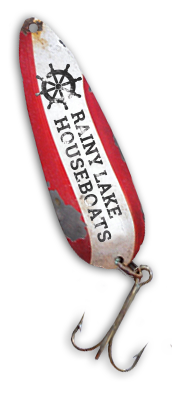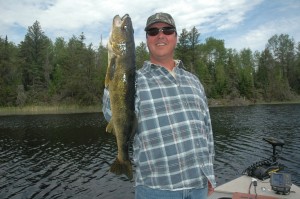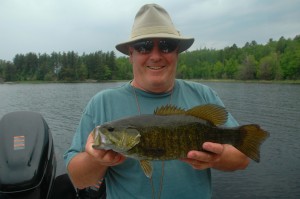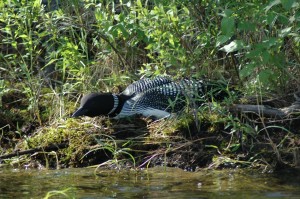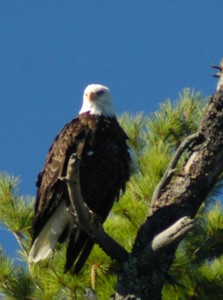Why does June fishing still excite me after forty seven years of guiding? June is the culmination of a series of phases that walleyes, smallmouth bass, northern
pike and crappies go through every year. The phases are pre spawn, spawn, post spawn, pre summer, and peak summer fishing. Pre spawn starts in early May
continuing until each species optimum spawning water temperature arrives. Warming water does an amazing thing to the fish. During the winter their
metabolism is slow, they feed but not aggressively. When the ice leaves the water begins to warm. As the length of each day gets longer along with warm sun it
eventually warms quicker. With the water getting warm in the bays fishes metabolism increases immensely. They feed aggressively and often. On Rainy Lake
northern pike spawn first, walleyes second, crappies third, smallmouth bass forth and muskies fourth. 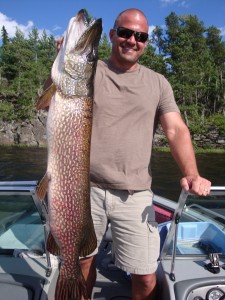 Pike like the one on
Pike like the one on
the right go into shallow dark bottom bays especially after 12:00 noon to digest breakfast. The water is capable of warming
seven to ten degrees from noon to five. The pike are aggressive sitting in the warm water. Where are they in the
morning? Look for rockpiles, points, shallow water reefs close to the dark bottomed bays. This pattern goes on throughout
the first two to three weeks of June.
Walleyes spawn with the water temperatures around 45 degrees. When the spawning happens male walleyes hold near
spawn areas, females move near these areas at night and tend to stay in the spawning areas for a while each day. Once
spawn is done walleyes feed in the bays. Remember the water is still cold so activity is slower, presentations need to be
slower as well. The spawning activities cease as the water warms. When it hits 50-52 degrees post spawn fishing ends
and pre summer begins.
Walleye action gets even better when the water temps hit the magical fifties range in temperature. Their
metabolism picks way up as body temperature increases. They locate on the existing structures in the bays. Fish
the areas with the wind blowing in. Live bait, plastics, stick baits and slip bobber presentations all work great. I
love this time of the year because the fish are active, you can use many different presentations, and find many
new spots in the bays that you have fished before.
When casting plastics, stick baits, or slip bobbers guests often say” I can believe there are fish that tight to the
structure. There is a reason the water is warmer the shallower the water. It is normal to catch these fish in 3-5 feet of water.
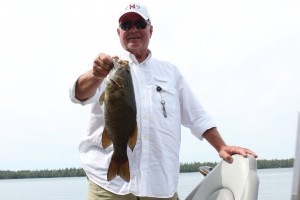 Smallmouth Bass are somewhat different than pike or walleyes. They spawn much later needing water around
Smallmouth Bass are somewhat different than pike or walleyes. They spawn much later needing water around
56-57 degrees to spawn. They spawn differently as well. They use a bed that the male smallmouth makes. When
conditions are right the female shows up and they mate just above the nest. This activity can take as little as an
hour or part of a day. When ice out occurs and the first three to four days of good sun occurs the smallmouth
move into the bays they spawn in. Smallies school together locating along walls at first, the rock walls absorb
heat and warms the water quicker. They move to points still schooled. Bass feed aggressively before
water temps hit 57 degrees. Years ago the Ontario Ministry of Natural Resources did a study on smallmouth bass spawning. They used smallies on Lake of the
Woods and also from Algonquin Provincial Park. To cut to the chase they determined that the male who guards the nest and mates is picked a year before
spawning. If the bass is killed before spawning the female absorbs the eggs and no spawning occurs. I believe that the heavy schooling they do when they move
a two fold reason. One they are able to find and keep track of mates but another huge reason is the bass survival
mechanism. They have no teeth just a sand like feel on their lips. We used to catch them and put them in the
live well until they quit biting or lost one. It was strange you would see schools following eating
what the one hooked was throwing up. Lose the fish and no more strikes. They release a pheromone into the
water; call it a fear pheromone if you want and it causes the school to disperse immediately. When the water hits
10 days not leaving until the fry hatch. After that it heavy feeding for the rest of the month and frankly right through fall.
June is an awesome time to come on a Rainy Lake Houseboat vacation, the fishing is incredible but a few other things are going on that will interest both the
fisherman and those that like to other wilderness events that occur at this time like eagle and loon watching.
